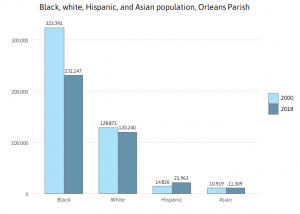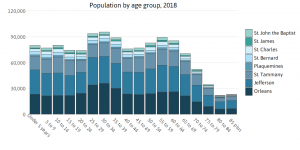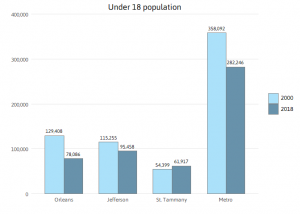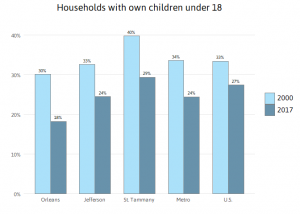Percentages of Different Race Within the City
 It doesn’t take too much digging to discover the conditions of how children are living within the city borders of New Orleans. It immediately becomes prominent if one were to look at the statistics. The city itself is currently at a population of about 423,656. It has been scientifically proven that detrimental environments and increased trauma within the earlier stages of a child’s life can cause a large set back in the child’s brain development. Between 2000 and 2010, the metro area lost 22 percent of children under 18 compared to only seven percent of all adults. Now, of course, this study spaced throughout the timeline of Hurricane Katrina and it’s the horrific impact on the city. But what can this say about any up and coming storms that could be even more horrific given the worse existing conditions due to climate change? Specific parishes that were affected the most traumatically were Orleans, Plaquemines, and Jefferson, experiencing greater losses among children than among adults. Now, moving on to the more recent statistics…
It doesn’t take too much digging to discover the conditions of how children are living within the city borders of New Orleans. It immediately becomes prominent if one were to look at the statistics. The city itself is currently at a population of about 423,656. It has been scientifically proven that detrimental environments and increased trauma within the earlier stages of a child’s life can cause a large set back in the child’s brain development. Between 2000 and 2010, the metro area lost 22 percent of children under 18 compared to only seven percent of all adults. Now, of course, this study spaced throughout the timeline of Hurricane Katrina and it’s the horrific impact on the city. But what can this say about any up and coming storms that could be even more horrific given the worse existing conditions due to climate change? Specific parishes that were affected the most traumatically were Orleans, Plaquemines, and Jefferson, experiencing greater losses among children than among adults. Now, moving on to the more recent statistics…
2018

The Dynamics Between Parents, Children, and Poverty
In the city of New Orleans, the share of adults with less than a high school degree fell from 25 percent to 14 percent but is still higher than the U.S. average of 12 percent. What does this mean within our research? The higher the educational attainment, the higher the income and internet access. Although most New Orleans parents are in the workforce, low-wage jobs are still much too prevalent to provide proper support towards a child. The child poverty rate in New Orleans is statistically unchanged from 1999. In Jefferson Parish, the child poverty rate jumped from 20 percent in 1999 to 28 percent in 2017 — greatly surpassing the U.S. child poverty rate, which rose from 17 to 18 percent between 1999 and 2017.




The share of households with children is shrinking while the share of individuals living alone is growing — both across the metro and nation. As of 2017, 24 percent of households in metro New Orleans included children, down from 34 percent in 2000. The metro had 358,092 children under 18 years in 2000 and only 282,246 in 2018. Much of this loss was driven by Orleans Parish, where the under 18 population declined to 78,086 from 129,408. The under 18 population is now 22 percent of the metro population, down from 27 percent in 2000.
Where To Go From Here
38 percent of our children below the age of 18 live in poverty. That is 10 points higher than the rest of Louisiana and twice the 19 percent national child poverty rate. So what can be done?
Access to adequate health care and education as well as public safety and infrastructure must be provided. The city also must provide systems for dealing with blight (plant disease) and regulating zoning decisions to make sure housing is available for a fair price and that neighborhoods are safe and livable. On top of this, small organizations like I had mentioned in the previous article can make a massive impact on viable living. Climate change is taking properties and making the situation much more difficult. For the city to continue to come together and create better management practices, huge impacts can be made.
Sources:
https://www.datacenterresearch.org/data-resources/who-lives-in-new-orleans-now/
https://www.nola.com/opinions/article_0fc48978-a57e-55d8-a656-05ea53586635.html
Leave a Reply